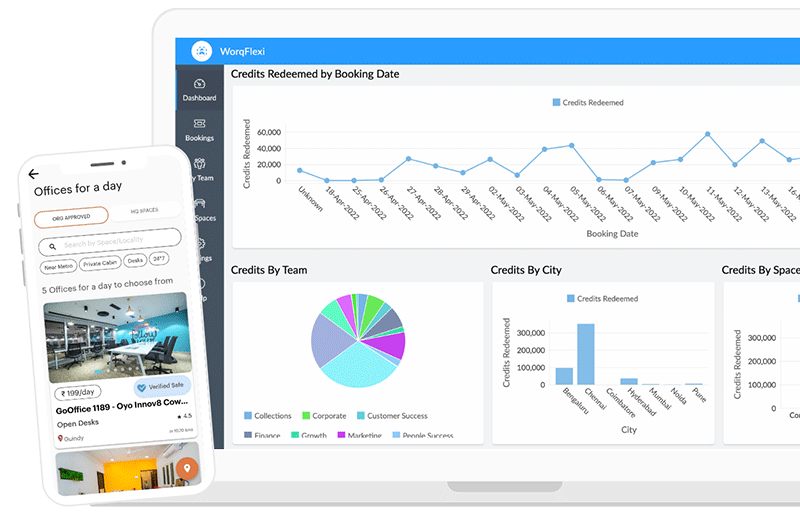Hybrid work
How Hybrid Working Can Help You Make More Profit! Find Out!
Soundhariya Viswanathan / Reading Time : 6 mins
A hybrid future is emerging between employers and employees as the return-to-work debate heats up. Eighty-three percent of executives forecast cost savings from hybrid work, and sixty percent expect their office space to be reduced by 50 percent or more. All industries except energy had real estate costs between 3% and 9% of their budgets before the pandemic. As a result, we are left to ask: Is switching to remote or hybrid work cheaper?
Recently, Fortune explored how companies are saving money by switching to hybrid or remote work models and downsizing their real estate. We were intrigued by the following numbers:
- Earlier it was normal to provide 150 sq ft of space per employee, now this is an expense
- 83% of executives surveyed expected hybrid work to bring down costs
- Some modes of saving identified include:
- Reducing leased or owned real estate
- Making use of a pay-as-you-go flexible workspace
Savings from these changes could be:
- 50% on their real estate costs when they switch to hybrid
- And a sizeable amount of savings per employee once they start hybrid work (mainly because of reduced rent)
Some benefits that business heads see with hybrid work (other than savings) include:
- Increased productivity
- Lower absenteeism
- Lower employee turnover
Data about workplace usage in real-time enables employers to tailor workplace solutions to meet their needs. Employers should tailor policies so that they reflect employee wants (and respect them), without overspending on unnecessary features.
Fact: In a recent survey, Cisco found that the average saving has been a little over US$150 per week, which works out to approximately $8,000 a year per employee.
Several companies had taken the hybrid approach long back and have been successful at it.
A study by NoCo demonstrated the positive impact hybrid working had on their company as a whole.
🏢 40% reduction in city centre sq. ft requirement
💸 50% savings per employee when city centre leased office space is replaced by suburban flexible office space
⏱️ 90% less time commitment required when comparing flexible workspace terms vs traditional leasing terms
🚗 Flexible workspace 25% more cost efficient versus supplying employee with a city centre car space
😊 Employees spend 260 hours less commuting to work
Hybrid remote work is steadily becoming popular among employers & employees alike. Here are some reasons why employees love it!
Reason to love ❤️ #1 Lesser shuttling between home and work

The average travel time for an office goer is about an hour each way. Imagine saving on these hours will help in on-time logging in, no traffic jam excuses, starting meetings on time, and starting work on time. Reduced commuting means the average office goer can sleep in for some extra time and be fresh when he/she logs into work. They can also save on expenses surrounding these commutes – be it fuel for the vehicle or daily metro/bus tickets/passes. Add to this the lesser amount of pollution an office goer will be causing while travelling to and from work.
Reason to love ❤️ #2 Work Flexi

Flexible working is what attracts and retains employees in a company. These working arrangements enable them to work around their schedules more efficiently. Additionally, employees can participate in office activities via the internet through their smartphones or laptop while taking care of their children.
Reason to love ❤️ #3 Personal freedom

A hybrid work environment means you do not have to get into a battle with your colleagues to increase or decrease the temperature at work - they get to set the optimal temperature at their home or hybrid workplace. This also allows for productivity. Hybrid work also means you can wear clothes you are comfortable in, giving employees a sense of personal freedom.
Let's look at some findings:
- HP posted some findings early this month with regard to hybrid work. Approximately 72% of their employees found that the hybrid model improves their productivity & a whopping 92% believed it gave them the much desired work-life balance.
- Cisco's recent Hybrid Work Study showed that 64.2% employees saved 4+ hours a week and 25.8% saved 8+ hours a week during remote work in 2021.
- Overall, the Cisco study indicated the following benefits of hybrid work (India)
- 88% saved money through hybrid work in the past year
- 72% believe hybrid working has had a positive impact on their physical fitness
- 90% say that hybrid working has improved family relationships
- 90% said the ability to work hybrid has made them happier and more motivated in their role
- 42% report that hybrid working has decreased their stress levels
- Accenture conducted a study recently to find that 58% of those surveyed had been working in a hybrid mode during the pandemic. They reported better mental health, stronger working relationships, and less burnout than those who worked entirely on-site or entirely remotely. The study also said that 83% of them felt a hybrid work model would be the best mode of working going forward.
- Microsoft's Work Trend Index also reports that employees want to continue working hybrid after Unlock stage.
- Indian IT giants Wipro, TCS, Infosys, HCL Tech, too are opting to continue the hybrid work.
- Real estate consultant Colliers conducted an India study which indicated that 3 days a week at the office was the most popular mode. It was the best way to further business goals and at the same offer work-life balance to employees.
The role of coworking aggregator platforms
Aggregator platforms like GoFloaters are helping companies with hybrid remote working. Some companies have implemented a coworking pass model of hybrid remote working where they enable their employees to work from a coworking space near home whenever they want. Occasionally teams also get together to brainstorm and work together.
One such company is a product company with over 1000 employees across India. Before the pandemic, all of these employees used to work from their HQ. Around 700 of their employees have leveraged GoFloaters to get a workspace near their homes over the last 7 months. When we check the cost savings from office rent alone, this company saved around 80% on office rent or around Rs 6500 per employee per month. This amounts to over INR 3.4 Crores in office rent savings (over the 7 months).
Some of the other companies that GoFloaters is working with have implemented a different hybrid remote approach. These companies provided a quarterly budget to each team to have offsites once a quarter where all of their team members would assemble in one city and work together for 2 weeks every quarter. Even with this model, these companies are saving over 50% on office rent or around Rs 4000 per employee per month after factoring in travel and stay costs during the offsite duration
Choose the right partner for a future-proof workspace strategy
The pandemic accelerated company culture changes more than anything we've seen in the past. This has led to an increase in casual working arrangements as employees seek more flexibility in their daily lives.

GoFloaters provides strategic & tactical flexible solutions to teams, startups, businesses, and enterprises who are looking to rework their hybrid work model based on various factors influencing their decisions and adoption. With WorqFlexi, we help you understand and implement hybrid work because in the new era of work.
Because its benefits are extensive and far-reaching
Don’t take our word for it!
Here is our Worqflexi calculator which also gives you a chance to understand how much you will save if you go hybrid. Go ahead, and check it out.
